Helios
Overview
Helios, often known simply as “the Titan,” was the son of the Titans Hyperion and Theia. He served as both the god of the sun and the sun personified. Every day, Helios drove his chariot across the sky to bring light to the world. In one myth, Helios’ rash son Phaethon tried to drive the blazing chariot himself, but he lost control of the horses, scorched the earth, and was ultimately killed.
Though Helios was treated with awe and reverence by the ancient Greeks, he was rarely worshipped. His cult did, however, become much more important in later antiquity, when the sun god came to be identified with the more powerful Apollo, the Olympian god of divination, healing, and the arts. (Similarly, Helios’ sister Selene was increasingly identified with Apollo’s sister Artemis.)
Etymology
The name “Helios” (Greek Ἥλιος, translit. Hḗlios) was also the ancient Greek word meaning “sun.” Variant spellings include the Homeric Ἠέλιος (Ēélios), the Doric and Aeolic Ἅλιος (Hálios) or Ἀέλιος (Aélios), and the Cretan Ἀβέλιος (Abélios) or Ἀϝέλιος (Awélios).
The ancient Greeks suggested several fanciful etymologies for Helios’ name: Plato, for example, derived the name (and the noun) from either the verb ἁλίζειν (halízein), meaning “to collect” (because the sun “collected” humans whenever it rose), or from the phrase ἀεὶ εἱλεῖν (aeì heileîn), meaning “to turn constantly” (because the sun was constantly turning around the earth).[1]
The Suda, on the other hand, connected the word to either ἀολλίζεσθαι (aollízesthai), meaning “to come together” (because of the “coming together” that occurs during the daytime), or to ἀλεαίνειν (aleaínein), meaning “to warm.”[2]
Nowadays, these efforts are regarded as folk etymologies. It is more likely that Helios’ name (and the Greek noun with which it is identical) comes from the Indo-European word for sun, *seh₂u-el-.[3]
Pronunciation
English
Greek
Helios Ἥλιος (translit. Hēlios) Phonetic
IPA
[HEE-lee-os, ‐ohs] /ˈhi liˌɒs, ‐ˌoʊs/
Alternate Names
Helios was sometimes known as Hyperion (also his father’s name), which means “high one” or “he who moves above”—an appropriate name for a sun god. Very often he was simply called “Titan” or “the Titan.”
Over time, Helios became identified with other gods, most notably Apollo. His Roman counterpart was called Sol (from the Latin word meaning “sun”).
Titles and Epithets
Helios’ epithets included ἠλέκτωρ (ēléktōr, “beaming, radiant”), ἐλευθέριος (eleuthérios, “liberator”), πανόπτης (panóptēs, “all-seeing”), σωτήρ (sōtḗr, “savior”), and φοῖβος (phoîbos, “bright”)—an epithet shared with Apollo, with whom Helios was sometimes identified.
Attributes
Functions
Helios was the Greek god of the sun. He was responsible for the daily journey of the sun across the sky, which he carried out in a golden chariot drawn by four fiery steeds.
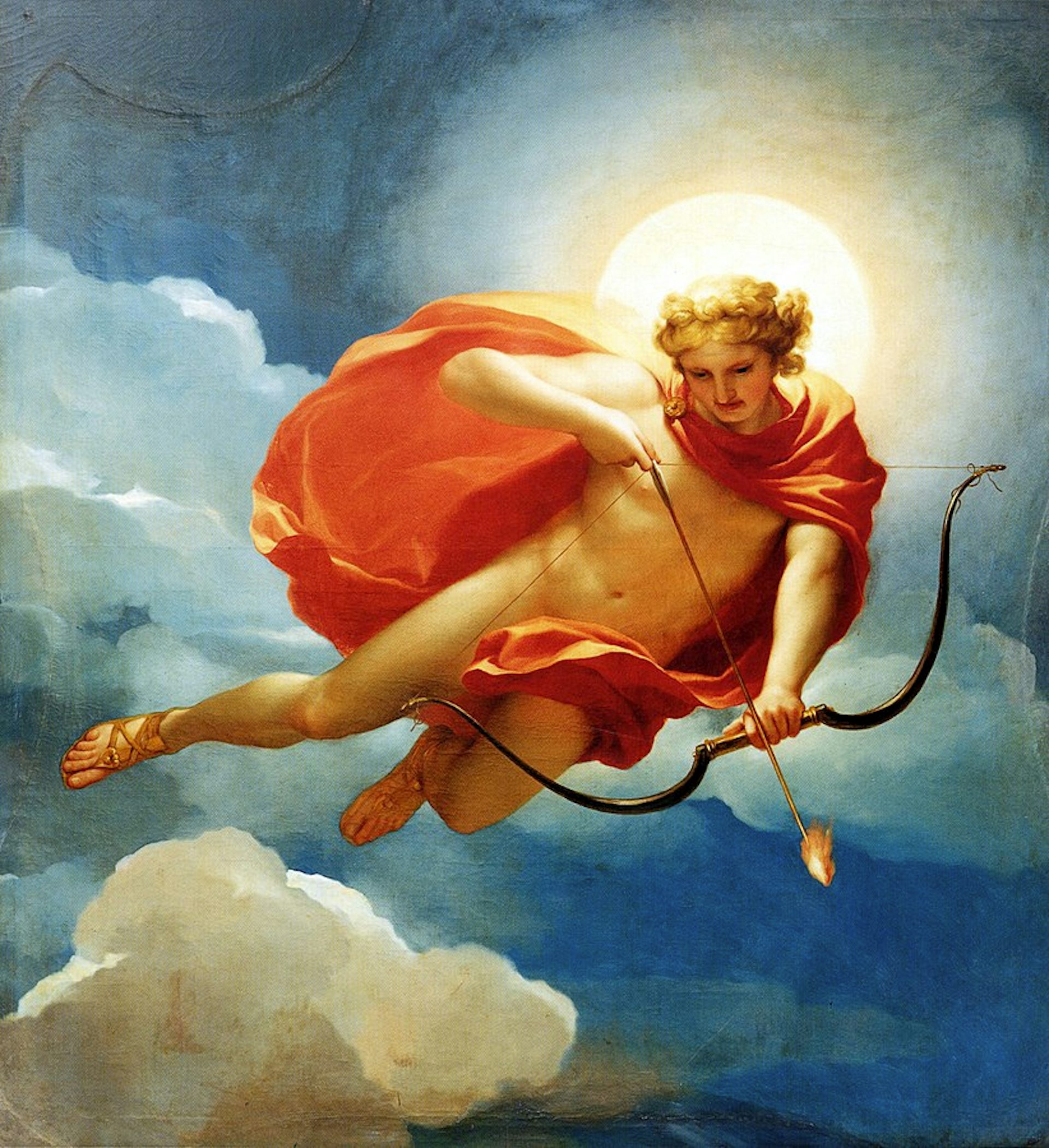
Helios as Personification of Midday by Anton Raphael Megs (1765). Palace of Moncloa, Madrid, Spain
Hellenica WorldPublic DomainAs he surveyed the world from his sun chariot, Helios observed everything that happened to both gods and humans, making him the most “all-seeing” of all the deities (second, perhaps, only to Zeus). In this capacity, Helios was often regarded as an upholder of cosmic order and justice[4] and was sometimes named as a guarantor of oaths.[5]
As the god of the sun and of solar activity, Helios was also connected with solar eclipses. The Greeks tended to view eclipses (both solar and lunar) as evil omens, signs that the gods needed to be placated.[6]
Helios’ functions subtly changed over time. Originally, he seems to have been conceived merely as a personification of the sun. But since Helios, like the sun, was all-seeing, his range of powers gradually expanded. By the Hellenistic period (323–31 BCE), it had become common for the Greeks to identify Helios with Apollo, one of the most important Olympian gods. Later, by the time of the Roman Empire, Helios (or Sol, as the Romans knew him) was increasingly seen as the dominant power in the cosmic order.[7]
Attributes
Helios was usually imagined as a handsome and youthful god. A vivid description of him can be found in Homeric Hymn 31, dedicated to Helios:
As he rides in his chariot, he shines upon men and deathless gods, and piercingly he gazes with his eyes from his golden helmet. Bright rays beam dazzlingly from him, and his bright locks streaming from the temples of his head gracefully enclose his far-seen face: a rich, fine-spun garment glows upon his body and flutters in the wind: and stallions carry him. Then, when he has stayed his golden-yoked chariot and horses, he rests there upon the highest point of heaven, until he marvelously drives them down again through heaven to Ocean.[8]
The chariot of the sun was Helios’ most famous and important attribute. Every day, it traveled west across the sky, drawn by four horses. The horses’ names were given as either Eous (“Dawn”), Aethiops (“Scorcher”), Bronte (“Thunder”), and Sterope (“Lightning”), or as Pyrois (“Fiery”), Eous (“Dawn”), Aethon (“Blazer”), and Phlegon (“Burner”). Other sources named only two steeds: Abraxas and Therbeeo.[9]
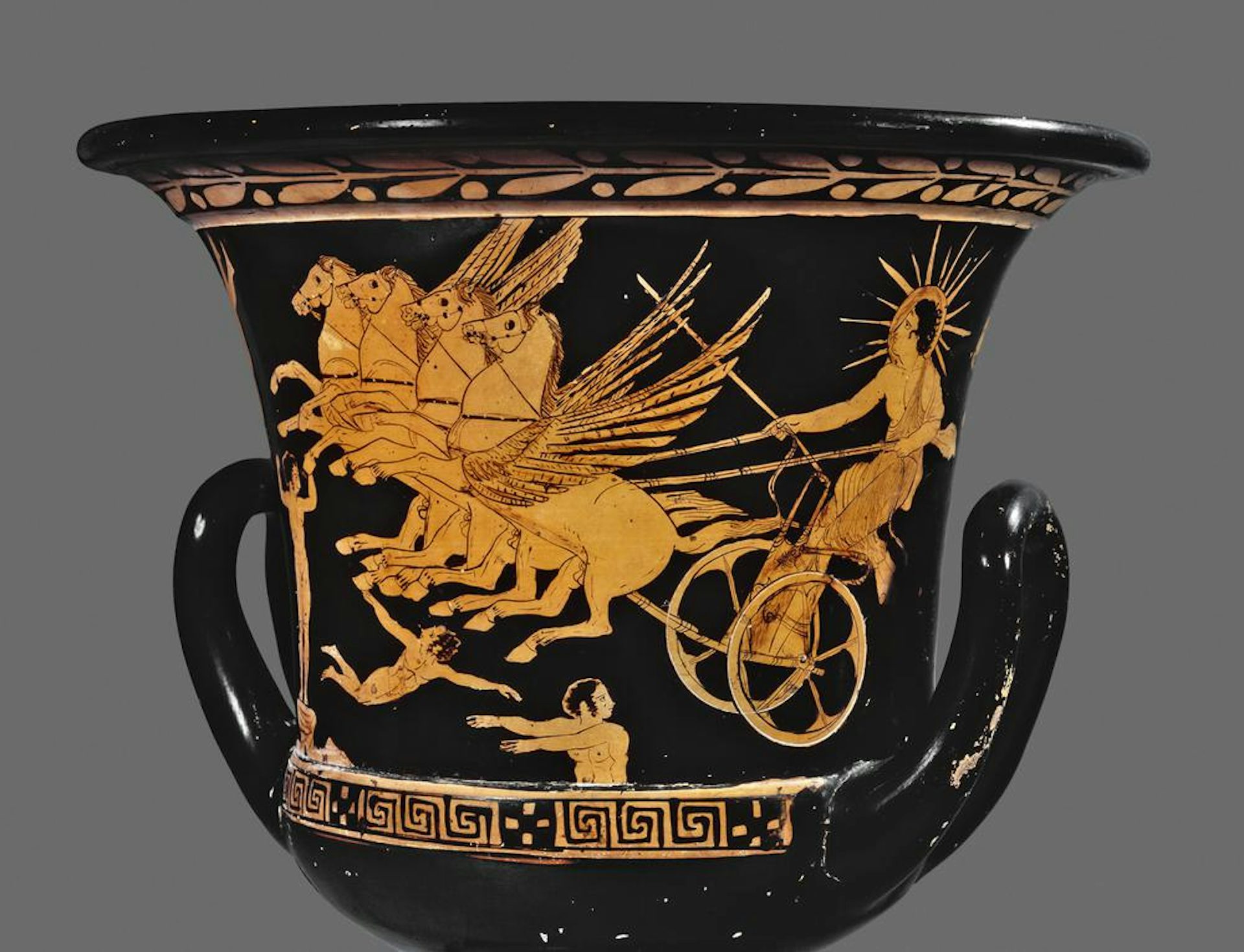
Red-figure calyx-krater showing Helios riding his chariot out of ocean (ca. 430 BCE). British Museum. Excavated in Puglia, Italy.
British MuseumCC BY-SA 4.0Sometimes, Helios was said to have attendants who accompanied him on his daily journey. These included the morning star Eosphorus,[10] the evening star Hesperus,[11] and the Horae.[12]
Over time, different authors added various details to Helios’ description: he had golden hair,[13] a robe woven from the twelve constellations,[14] and wore a crown or halo made up of the sun’s rays; he possessed a magical salve that protected him from the fire breathed by his horses;[15] and after completing his daily journey across the sky in his sun chariot, he would sail back to his home in the east in a beautiful golden goblet.[16]
Residence and Sacred Sites
Some sources offered details about Helios’ residence. Homer, for example, wrote of the “Gates of Helios,” located far in the west, near the end of the vast stream of the Ocean and the entrance to the Underworld.[17] The Roman poet Ovid described Helios’ palace as follows:
Glowing with gold, flaming with carbuncles
on stately columns raised, refulgent shone
the palace of the Sun, with polished dome
of ivory gleaming, and with portals twain
of burnished silver. And the workmanship
exceeded all the wealth of gems and gold...[18]
Besides his home, Helios had several sites that were considered uniquely sacred to him. Perhaps the most important of these were the islands of Thrinacia (sometimes identified as Sicily)[19] and Rhodes.[20]
Symbols and Iconography
Helios’ most obvious symbol was the sun. But he had other symbols, too, including sacred animals such as the rooster[21] and sacred plants such as heliotrope[22] and frankincense.[23] He also possessed a sacred herd of cattle said to live on the island of Thrinacia.[24]
In ancient art, Helios was represented as a handsome and youthful god. He was most readily distinguished by his halo or crown and his four-horse chariot. The most famous ancient representation of Helios was the Colossus of Rhodes, a giant statue erected in the port of Rhodes which was counted as one of the Seven Wonders of the Ancient World.[25]
Family
According to Hesiod, Helios was the son of the Titans Hyperion and Theia and thus the brother of Selene and Eos.[26] But other sources named his mother as Euryphaessa,[27] Aethra,[28] or Basileia[29] (possibly alternate names for Theia).
Helios was not usually represented with any single queen or consort. Instead, he had many lovers, who in turn gave him many children. Helios was the father of Phaethon by either Clymene,[30] Prote,[31] or Rhode;[32] of Aeetes and Circe by either Ephyra,[33] Perse (or Perseis),[34] Antiope,[35] or Asterope;[36] of the Heliades by either Clymene,[37] Neaera,[38] Prote,[39] or Rhode;[40] and of the seven Heliadae by Rhodos.[41]
These are just a few of Helios’ countless consorts and children (for a more exhaustive list, see here). Sometimes, the virtually omnipresent Helios was also called the father of the Graces,[42] Eos,[43] Selene,[44] Medea,[45] and even Helen of Troy (among others).[46]
Family Tree
Mythology
Phaethon and the Chariot of the Sun
The most important myth surrounding Helios is actually focused on his mortal son Phaethon, whose ill-fated attempt to drive the chariot of the sun ended in his death.[47]
In the best-known tradition, Phaethon was raised not by Helios but by his mother (whose name was either Clymene, Prote, or Rhode, depending on the source) and her husband (usually called Merops). When Phaethon had grown to early adulthood, his mother revealed the truth about his parentage, and the bold Phaethon immediately traveled to the heavenly palace of the sun to meet his father. There, Helios made the grave error of promising Phaethon any gift he wanted. Phaethon foolishly demanded to drive Helios’ famous chariot of the sun.
Helios tried to warn his son of how dangerous this request was, but Phaethon was persistent. Reluctantly, Helios turned over the reins (in a different version of the myth, Phaethon stole the chariot and drove it without his father’s permission).
Sure enough, the inexperienced Phaethon lost control of the chariot. Flying too low, it scorched much of the earth:
And even as the ground asunder burst,
the light amazed in gloomy Tartarus
the King Infernal and his Spouse. The sea
contracted and his level waste became
a sandy desert. The huge mountain tops,
once covered by the ocean's waves, reared up,
by which the scattered Cyclades increased.
Even the fishes sought for deeper pools;—
the crooked dolphins dared not skip the waves;
the lifeless sea-calves floated on the top;
and it is even famed that Nereus hid
with Doris and her daughters, deep below
in seething caverns. With a dauntless mien
thrice Neptune tried to thrust his arms above
the waters;—thrice the heated air overcame
his courage.[48]
Zeus, realizing that Phaethon would soon wipe out all life on earth, struck him down with a lightning bolt, and Phaethon fell from the chariot to his death. There may have been another version, though, in which it was Artemis who shot Phaethon down with her arrows.[49]
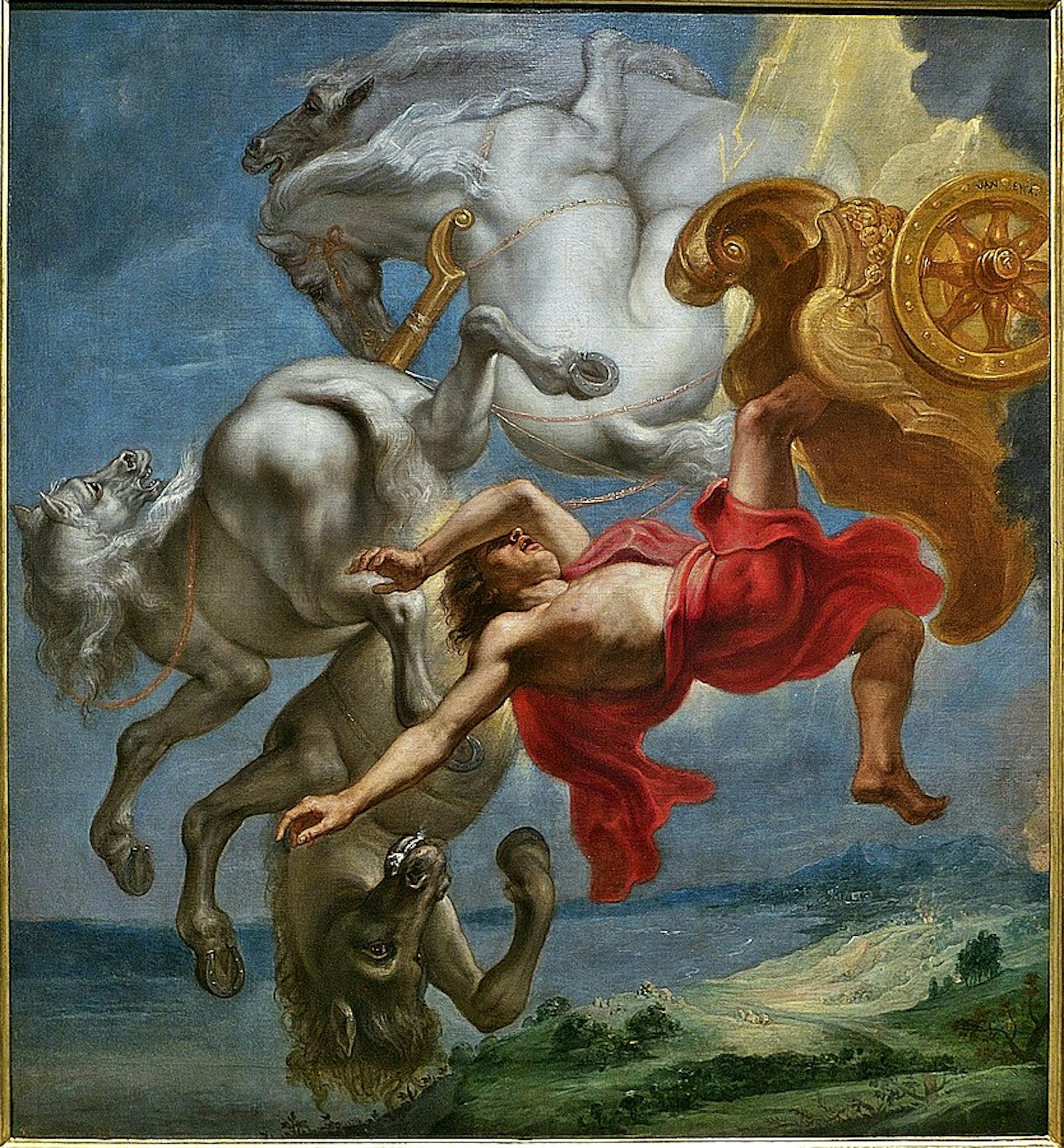
The Fall of Phaethon by Jan Carel van Eyck (1636–1638). Prado Museum, Madrid, Spain.
Jl FilpoCCC BY-SA 4.0Phaethon’s death was, of course, a terrible blow to both of his parents. But it was Phaethon’s sisters (or half-sisters), usually known as the Heliades, who were the most heartbroken of all. Together with their mother, the Heliades wandered the earth until they found Phaethon’s body: he had fallen near the Eridanus, a remote mythical river located somewhere in Central Europe. After they buried Phaethon, the Heliades wept for him unceasingly until they were at last transformed into poplar trees, which weep tears of amber.[50]
All-Seeing Helios
Several myths highlight Helios’ vigilance as the all-seeing god of the sun.
Perhaps most famously, Helios appears in many accounts of the abduction of Persephone. As the story goes, Hades, the ruler of the Underworld, fell in love with his niece Persephone and snatched her away to the Underworld to be his bride. Persephone’s mother Demeter, realizing her daughter was missing, searched desperately for her.
Eventually, Hecate advised Demeter to ask Helios if he had seen what had happened. As it turned out, Helios had witnessed the whole thing, and he told Demeter of how Hades had abducted Persephone while she was playing in a meadow.[51] With this information, Demeter was able to force Hades to return Persephone to her (though Persephone still had to spend a part of every year with her Underworld husband).
In another myth, Helios was making his daily journey across the sky when he happened to notice that Aphrodite, the wife of Hephaestus, was having an affair with the war god Ares. He immediately went to tell Hephaestus, who, as a master craftsman, was able to devise a crafty revenge: he wove a net so fine that it was invisible to the naked eye, which he spread across his bed. The next time Aphrodite and Ares went to bed together, he caught the lovers in the net and displayed them to the ridicule of all the other gods.[52]
Unfortunately, Aphrodite held Helios responsible for her humiliation; after all, he was the one who had tattled to her husband Hephaestus. Thus, she decided to punish Helios and/or his descendants, either by causing Helios’ daughter Pasiphae to fall in love with the Cretan Bull,[53] by causing Helios’ granddaughter Phaedra to fall in love with her stepson Hippolytus,[54] or by causing Helios’ own tragic affair with Leucothoe.[55]
Helios in Love
Like most other male gods, Helios had many love affairs, not all of which ended happily.
In one myth, Aphrodite wanted to take revenge on Helios for informing Hephaestus of her affair with Ares. Thus, she made Helios fall in love with Leucothoe, a beautiful mortal princess, while simultaneously forgetting his previous lover, the Oceanid Clytie.
Smitten, Helios pined for Leucothoe from above. One day, he took the form of Leucothoe’s mother Eurynome, entered the girl’s room, and dismissed the servants. There he revealed his true identity and had his way with Leucothoe.
But the jealous Clytie, who still loved Helios, betrayed Leucothoe’s affair to her father Orchamus. Furious, Orchamus punished his daughter by burying her alive. Helios eventually came to rescue his lover, but he was too late: Leucothoe was dead. Though Helios could not bring Leucothoe back to life, he did “immortalize” her by transforming her into a frankincense tree.
Clytie, meanwhile, had hoped that Helios would come back to her if Leucothoe were out of the picture. But she was disappointed: angry at Clytie’s role in Leucothoe’s death, Helios would not even look at her. The devastated Clytie stripped herself naked and sat on a rock, unmoving and staring mournfully at the sun. In the end, she was transformed into the heliotrope, a purple flower said to always face the sun.[56]
Helios and the Gigantomachy
Helios was usually said to have sided with the Olympians in the Gigantomachy, a brutal war between the Olympians and the Giants (a monstrous race born from the earth goddess Gaia).
Before the war had even begun, Zeus was making preparations. Some said that he sacrificed to Helios and several other Titans in an effort to convince them to join his cause.[57] In one tradition, Zeus discovered that only a mortal could kill the Giants, but that there was a magical plant that would protect them even from a mortal’s blow. To prevent Gaia from finding this plant and giving it to the Giants, Zeus commanded Helios as well as his sisters Selene (the moon) and Eos (the dawn) not to shine; then he harvested all of the plant for himself and summoned the mortal hero Heracles to help fight the Giants.[58]
Some sources tell of how one of the Giants, Alcyoneus, provoked Helios by stealing his sacred cattle.[59] In certain versions of the myth, this may have actually been the offense that caused the whole war.[60]
During the fighting itself, Helios stood by the Olympians. In one tradition, he even rescued the god Hephaestus by lifting him up onto his chariot when he was exhausted from fighting.[61]
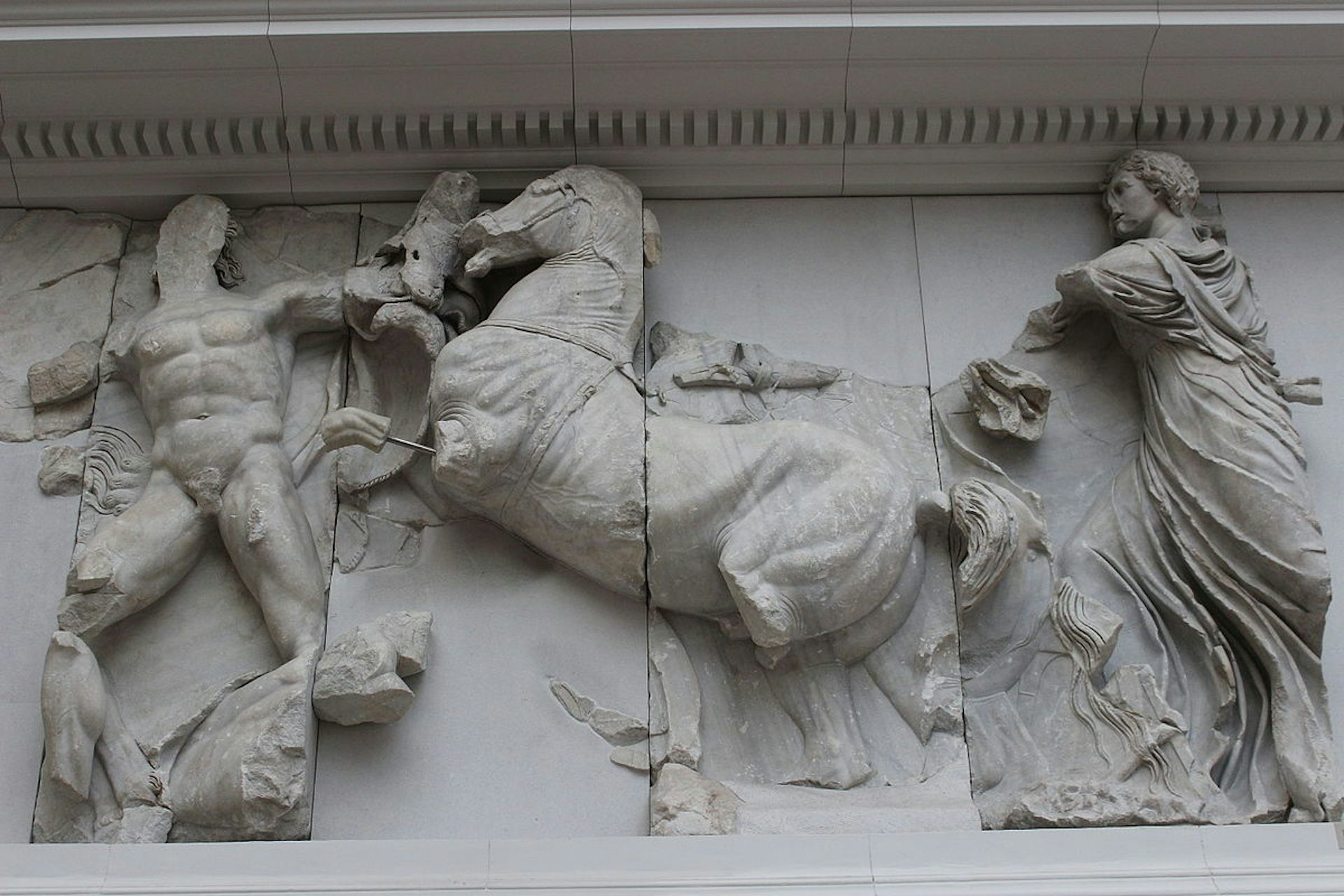
Relief from the Pergamon Altar showing Helios (right) fighting the Giants (2nd century BCE). Pergamon Museum, Berlin, Germany.
Miguel Hermoso CuestaCC BY-SA 4.0The Favor of Helios
A few myths describe the favor and generosity of sunny Helios.
In one myth, Helios helped Heracles when he was sent to fetch the cattle of the monstrous Geryon for his tenth labor; he let Heracles borrow his golden goblet to travel to Geryon’s remote home.[62]
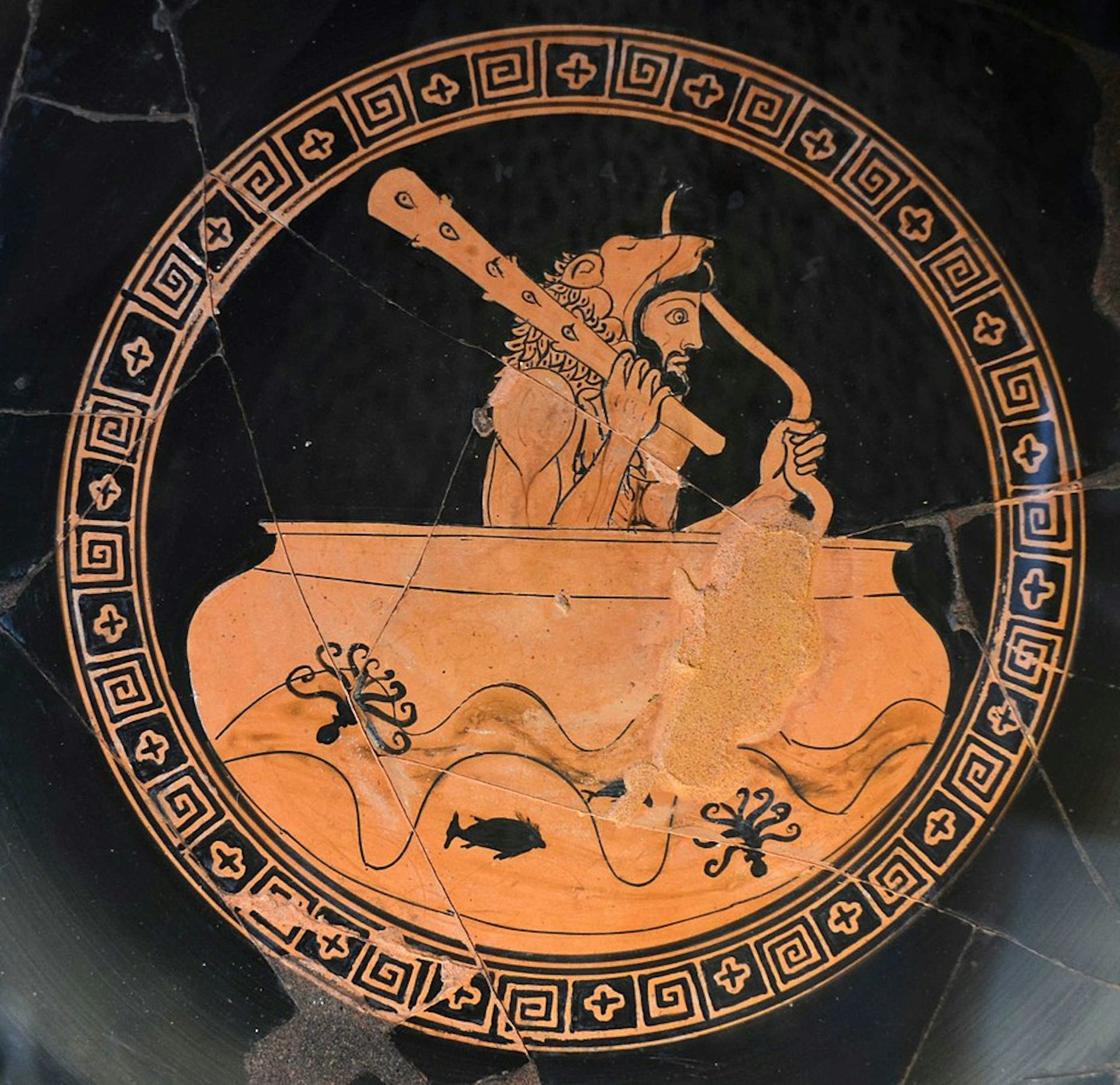
Tondo of a red-figure kylix showing Heracles sailing across the sea in the goblet of Helios. Attributed to Douris (ca. 480 BCE). From Vulci, Italy. Vatican Museums, Rome.
PompilosCC BY-SA 4.0In another myth, Helios restored the sight of the hunter Orion after a certain Oenopion had him blinded for sleeping with his daughter.[63]
Helios showed special favor to his family and descendants. To his son Aeetes, Helios was said to have given various wondrous gifts, including chariots, a palace, a robe, and even his kingdom of Colchis.[64] Helios was also generous with his granddaughter Medea (Aeetes’ daughter). For example, when Medea punished her wayward husband Jason by murdering his new bride-to-be (as well as, in some versions, the children that she had had with him), Helios lent her a dragon-drawn chariot to make her escape.[65]
The Wrath of Helios
Though usually seen as a gentle and benevolent god, Helios could be terrible in his wrath. A handful of myths tell of how he punished those who angered him.
Odysseus
The most famous story of Helios’ wrath occurred during the saga of Odysseus’ wanderings. Homer’s Odyssey tells of how Odysseus and his men arrived at the island of Thrinacia after spending years trying to find their way home from the Trojan War. Thrinacia was very dear to Helios: it was where the god kept his sacred cattle.
Though they had been warned not to harm Helios’ cattle, Odysseus’ men eventually gave into their hunger and ate one of the beasts. Helios, of course, was not happy. He complained to Zeus, who drove Odysseus and his men from the island, then stirred up a terrible storm that sank their ship. The only survivor was Odysseus, who alone had refrained from harming the cattle of the sun.[66]
Phineus
Helios was sometimes said to have been responsible for the blindness of the Thracian prophet-king Phineus. It appears that in this version of the myth, Phineus had had the hubris to challenge Helios to a contest (perhaps a prophecy contest). To make matters worse, Phineus won. Helios punished him by taking away his eyesight and sending the Harpies to torment him. The Harpies made it almost impossible for Phineus to eat: whenever he sat down for dinner, they would swoop down, snatch away much of his meal, and defecate all over the rest.
Phineus wasted away for a long time, until eventually the Argonauts chased away the Harpies in return for his prophecies. Helios, still angry, promptly transformed Phineus into a mole—a blind creature constantly scurrying and scavenging for food.[67]
Arge
In another myth, a huntress named Arge made an imprudent boast while pursuing a stag, announcing that she would catch the beast even if it was as swift as Helios. Offended, Helios turned her into a doe.[68]
Nerites
Another target of Helios’ wrath was Nerites. This Nerites was a handsome son of the sea god Nereus and a lover of Poseidon. He often accompanied Poseidon as the god traveled over the waves and was renowned as a fast swimmer. For reasons that are never specified in any surviving sources, Helios became angry at Nerites and turned him into a spiral shell.[69]
Two Foundation Myths
Helios also appears in the foundational myths of a few sites believed to be especially dear to him. One of these was the island of Rhodes. As the story goes, Helios was absent when the gods were dividing the earth among themselves, and so was accidentally left out. When Zeus discovered the mistake, he offered to recast the lots, but Helios assured him that there was no need. As the all-seeing sun, he knew that there was an island—Rhodes—that was soon to rise up from the sea. That, said Helios, would be his allotment.[70]
On Rhodes, Helios was also known as the father of the so-called Heliadae, seven brave men who played an important role in the mythology of Rhodes. It was they who drove the insolent Telchines from the island, founded the island’s most important cities, and established the local worship of the goddess Athena.[71]
Helios also competed with Poseidon to be the patron god of the city of Corinth (just as Athena had competed with Poseidon for Athens). The Corinthians, fearful of angering either one of these powerful gods, came up with a compromise: Helios would have the Acropolis, or “Acrocorinth,” the city’s hilltop citadel, while Poseidon would have the Isthmus, the narrow strip of land that connected the Peloponnese with the rest of mainland Greece.[72]
Worship
Helios was rarely worshipped in the early periods of ancient Greek history. He was honored widely, and many prayed to Helios at sunrise and sunset,[73] but he did not have much actual cult. In the fifth century BCE, the comedian Aristophanes even commented that offering sacrifices to the sun or moon was the mark of a barbarian, not a civilized Greek.[74]
However, there were some exceptions. In Rhodes, Helios was, in fact, the most important god. The famous Colossus of Rhodes—one of the Seven Wonders of the Ancient World—was erected in the harbor in honor of Helios in 280 BCE. Helios also had a festival, the Halieia, that was celebrated for him on Rhodes.[75]
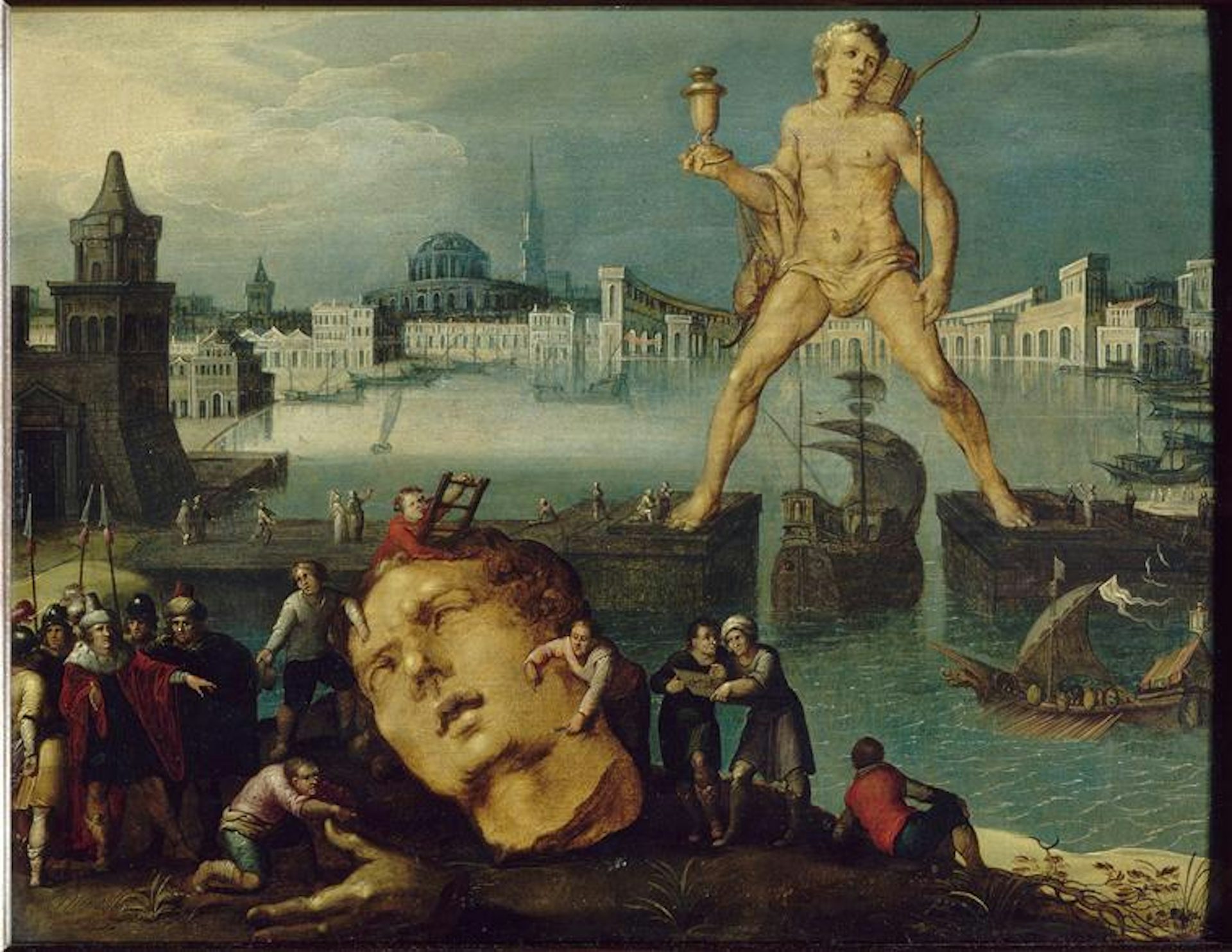
The Colossus of Rhodes by Louis de Caullery (before 1622). Louvre Museum, Paris, France.
Wikimedia CommonsPublic DomainIn later times, the cult of Helios became much more popular. Pausanias, a geographer writing in the second century CE, described temples, altars, and cults of Helios all over the Greek world, including at Corinth[76] and Sicyon[77] in central Greece; Hermione,[78] Mycenae,[79] and Troezen[80] in the Argolid; Bryseae[81] and Thalamae[82] in Laconia; Elis in the western Peloponnese;[83] and Mantinea in Arcadia.[84]
Helios’ appeal also expanded as he became more closely identified with Apollo. This identification already existed as early as the fifth century BCE,[85] but it became much more common in later periods.
By late antiquity, Helios was increasingly regarded as one of the most important gods of the entire pantheon. In 274 CE, the Roman emperor even established an official cult to Sol Invictus, the “Unconquered Sun,” known in Greek as Helios Megistos, “Greatest Sun.” Roughly a century later, Julian—the last of the pagan emperors—even made Sol/Helios the chief god of the state (though this development was short-lived, with Sol giving way to Christianity as soon as Julian died).
Pop Culture
Helios is rarely featured in modern adaptations of Greek mythology. When he does appear, he is associated with the sun and fire (as he was in antiquity); for example, in one episode of the 1990s TV series Hercules: The Legendary Journeys, Helios is represented as a Titan who has the power to transform himself into fire.